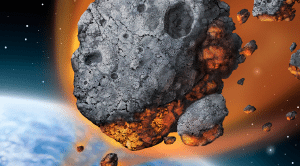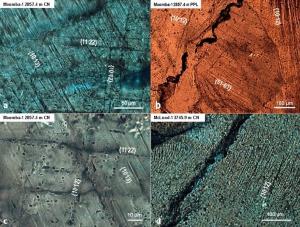Blog
Deep Impact
25 March 2015
 Wikimedia
WikimediaThere’s been news of the discovery of what could be the largest known meteor impact. The results have been published in Tectonophysics, but the results aren’t without controversy.1
Currently the largest confirmed impact basin is Vredefort crater in South Africa, with a diameter of about 300 km. Slightly smaller is Sudbury basin, at about 250 km across. This new impact in Australia, if confirmed, would be about 400 km across. The evidence comes from quartz crystals found in core samples taken from a region known as Warburton Basin. These crystals have a layered fracture structure that could be caused by the impact of a large meteor. Based upon the samples, there would seem to be two impact regions each about 200 km across. It could have been caused by a meteor that split in two before impacting the Earth about 350 – 400 million years ago.
 Glikson, et al
Glikson, et alWhile its an interesting idea, quartz fractures such as these could also have been caused by other seismic events such as earthquakes, so quartz fractures alone is not particularly compelling evidence for a meteor impact. There is some evidence of overall basin geology that could be caused by an impact, but it is very different from other impact regions. In particular, the work argues that the impact features are now about 3 km below the surface, which makes it particularly difficult to study. It also isn’t clear that the two regions would be due to the same impact, or from two separate impacts in a similar era. The latter might seem unlikely, but we can’t rule it out.
It’s certainly possible that a large impact occurred there. We know that large impacts have occurred in Earth’s history, and the size of this new impact is perfectly plausible. But it’s important to keep in mind that finding a possible impact isn’t the same as confirming an impact basin. There’s still plenty of work to be done before Warburton Basin can be added to the list of large impact events.
Glikson, Andrew Y., et al. “Geophysical anomalies and quartz deformation of the Warburton West structure, central Australia.” Tectonophysics 643 (2015): 55-72. ↩︎